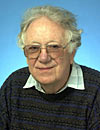Smithies’ work at UW-Madison underpinned Nobel Prize in Medicine
The gene targeting work for which North Carolina biologist Oliver Smithies was recognized for the 2007 Nobel Prize in Medicine has a distinct Wisconsin flavor.

Smithies
Photo courtesy: UNC-Chapel Hill
Smithies, who was named today (Oct. 8) with University of Utah researcher Mario R. Capecchi and Briton Martin J. Evans as co-recipients of science’s most prestigious award, was a University of Wisconsin–Madison professor of genetics from 1960-1988. The work for which he was recognized was, for the most part, accomplished at Wisconsin, according to several of his colleagues.
“One of my proudest accomplishments was helping to attract him here,” says James Crow, emeritus professor of genetics. “Everything he did had a characteristic touch of originality. Actually, just before he left here he did the major piece of work” that put him on the path to Stockholm.
In short, Smithies, independent of Capecchi and Evans, figured out how to manipulate DNA in a way that enabled scientists to add or subtract genes from the genome of a mouse and thereby create models of disease ranging from cancer to heart disease.
His work, according to UW–Madison genetics Professor Allen Laughon, “transformed the whole world of mammalian genetics.”
The technique Smithies developed involved introducing a desired genetic change into mouse embryonic stem cells and then injecting the altered cells into mouse embryos. The mice born from those embryos are then bred with others to produce offspring with altered genes.
Since the technique was announced in 1989, more than 10,000 different genes in mice have been studied with the method, according to the Nobel committee.
“Early in his career, he was interested in the knockout,” Crow explains of what scientists call animal models that have had genes removed. The technique enabled scientists to probe genetic mutations and changes that underpin disease in unprecedented ways. “Those were heady days.”
“Gene targeting has pervaded all fields of biomedicine. Its impact on the understanding of gene function and its benefits to mankind will continue to increase over many years to come,” reads the citation for the prize in recognizing the accomplishments of Smithies, Capecchi and Evans.
“At the time, he wanted to use cloning to get a model system,” recalls UW–Madison genetics professor Frederick Blattner. Blattner is the Oliver Smithies Professor of Genetics.
“We worked together for many years until he left,” Blattner says, noting that Smithies sought him out when he was a postdoctoral fellow at the UW–Madison McArdle Laboratory for Cancer Research and they published six or seven papers together. “That’s work (for which he was cited) he did while he was here.”
While Smithies was cited for developing a technique that has transformed the study of disease, Crow notes that even before arriving at Wisconsin in 1960 the British-born biologist had already invented a technology, starch gel electrophoresis, that is a mainstay of modern biological research. It allows scientists to separate DNA, RNA and proteins using an electric charge and a gel matrix, and is the basis for such common uses as DNA fingerprinting and any elementary study in molecular biology.
Smithies left UW–Madison in 1988 for the University of North Carolina at Chapel Hill, where he is the Excellence Professor of Pathology and Laboratory Medicine.
Tags: biosciences, faculty awards, international, research




